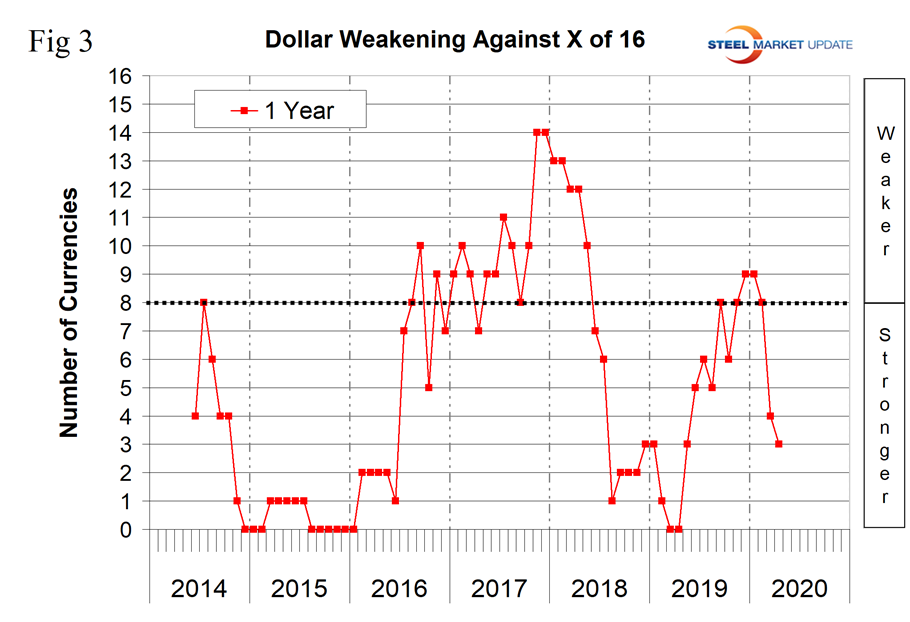Economy

Currency Update for Steel Trading Nations
Written by Peter Wright
April 15, 2020
The U.S. dollar strengthened against 14 of the 16 steel and raw materials trading nation currencies in the last three months and also in the last month. There was a turnaround in the last seven days when the dollar weakened against 14 of the 16. In the last three months, the currencies of Brazil, Mexico, Russia, South Africa, Turkey and Ukraine were down by double digits.
In this report we examine the change in currency values of the 16 preeminent global steel and iron ore trading nations. The currencies of these 16 don’t necessarily follow the Broad Index value of the U.S dollar, but in the last month they did. The latest value of the Broad Index as published by the Federal Reserve was April 10 on which date the dollar was stronger than at any time in the last 18 years. Our country data from Oanda was current as of April 13.
![]()
Figure 1 plots the daily Broad Index (BI) value of the U.S. dollar since 2013. By April 13, the dollar had appreciated by 6.7 percent since the end of December.

The story of the currencies of the steel and raw materials trading nations has been much more dramatic. At Steel Market Update, we track the currencies of these 16 nations on a daily basis and report monthly. Table 1 shows the number of currency units that it takes to buy one U.S. dollar and the percentage change in the last year, three months, one month and seven days. The overall picture for the steel trading nations is that in the last year the U.S. dollar has strengthened against 13 of the 16. In the last three months and one month, the dollar has strengthened against 14 and in the last seven days has weakened against 14. Table 1 is color coded to indicate weakening of the dollar in green and strengthening in red. We regard strengthening of the U.S. dollar as negative and weakening as positive because of the effect on net imports. Figure 2 shows the extreme gyrations that have occurred at the three-month level in the last four years.


Figure 3 attempts to remove some of the volatility from value changes of the 16 currencies under examination here. This shows the number of currencies against which the dollar was weakening on a year-over-year basis. In December 2019 and January 2020, the dollar was weakening against nine of the 16; by mid-April 2020 it was weakening against only three. A strengthening dollar puts downward pressure on globally traded raw materials prices.

The biggest changes in the last month were the Brazilian real, down 5.6 percent; the Mexican peso, down 7.3 percent; the South African rand, down 10.6 percent; and the Turkish lira, down 6.5 percent. (See the end of this report for details of data sources.)
Our files contain charts of the history of the value of all 16 steel trading nation graphs and are available on request.
Explanation of data sources: The Broad Index is published by the Federal Reserve on both a daily and monthly basis. It is a weighted average of the foreign exchange values of the U.S. dollar against the currencies of a large group of major U.S. trading partners. The index weights, which change over time, are derived from U.S. export shares and from U.S. and foreign import shares. The data are noon buying rates in New York for cable transfers payable in the listed currencies. At SMU, we use the historical exchange rates published in the Oanda Forex trading platform to track the currency value of the U.S. dollar against that of 16 steel trading nations. Oanda operates within the guidelines of six major regulatory authorities around the world and provides access to over 70 currency pairs. Approximately $4 trillion U.S. dollars are traded every day on foreign exchange markets.

Peter Wright
Read more from Peter WrightLatest in Economy

Architecture billings continue to slide in March
Architecture firms said billings continued to decline in March, according to the latest Architecture Billings Index (ABI) released by the American Institute of Architects (AIA) and Deltek.

Beige Book shows concerns about trade policy
Manufacturing was mixed, but two-thirds of districts said activity was little changed or had declined.

New York state manufacturing index drops again in April
Firms were pessimistic, with the future general business conditions index falling to its second lowest reading in the more than 20-year history of the survey

Construction adds 13,000 jobs in March
The construction sector added 13,000 jobs, seasonally adjusted, in March, but tariffs could undermine the industry.

Supply chains, end-users brace for impact from tariffs
Supply chains are working through what the tariffs mean for them
